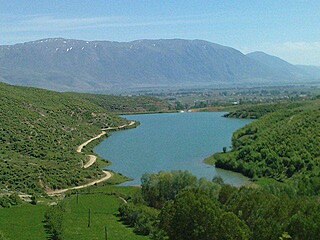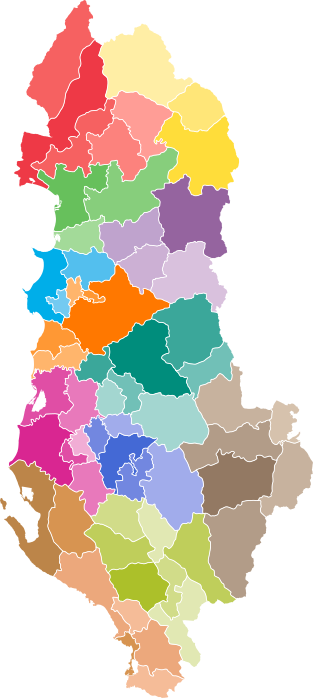Administrative divisions are geographical areas into which a particular independent sovereign state is divided. Such a unit usually has an administrative authority with the power to take administrative or policy decisions for its area.
A county is a geographic region of a country used for administrative or other purposes in some nations. The term is derived from the Old French comté denoting a jurisdiction under the sovereignty of a count (earl) or a viscount. Literal equivalents in other languages, derived from the equivalent of "count", are now seldom used officially, including comté, contea, contado, comtat, condado, Grafschaft, graafschap, and zhupa in Slavic languages; terms equivalent to 'commune' or 'community' are now often instead used.

Local government is a generic term for the lowest tiers of governance or public administration within a particular sovereign state.
Albania is a unitary parliamentary constitutional republic, in which the president of Albania is the head of state and the prime minister of Albania is the head of government in a multi-party system. The executive power is exercised by the Government and the prime minister with its Cabinet. Legislative power is vested in the Parliament of Albania. The judiciary is independent of the executive and the legislature. The political system of Albania is laid out in the 1998 constitution. The Parliament adopted the current constitution on 28 November 1998. Historically Albania has had many constitutions. Initially constituted as a monarchy in 1913, Albania became briefly a republic in 1925, and then a authoritarian monarchy in 1928. In 1939 Albania was invaded by Fascist Italian forces, imposing a puppet state, and later occupied by Nazi German forces. Following the partisan liberation from the Nazis in 1944 a provisional government was formed, which by 1946 had transformed into a communist one-party state. In March 1991 democracy was restored with multi-party elections.
A district is a type of administrative division that in some countries is managed by the local government. Across the world, areas known as "districts" vary greatly in size, spanning regions or counties, several municipalities, subdivisions of municipalities, school district, or political district.
Counties, also sometimes known as prefectures, are the first-level administrative subdivisions of Albania, replacing the earlier districts. Since 2000, there have been 12 counties. Since 2015, they have been divided into 61 municipalities, 373 communes, and 2,972 villages.

For local government purposes, Scotland is divided into 32 areas designated as "council areas", which are all governed by single-tier authorities designated as "councils". They have the option under the Local Government (Scotland) Act 1997 of being known as a "comhairle" when opting for a Gaelic name; only Comhairle nan Eilean Siar has chosen this option, whereas the Highland Council has adopted its Gaelic form alongside its English equivalent, informally.

Durrës County, officially the County of Durrës, is a county in the Northern Region of the Republic of Albania. It is the smallest by area and the second most populous of the twelve counties, with 292,029 people within an area of 766 km2 (296 sq mi). The county borders on the Adriatic Sea to the west, the counties of Lezhë to the north, Dibër to the east and Tirana to the south. It is divided into three municipalities, Durrës, Krujë and Shijak, with all of whom incorporate sixteen administrative units.

Fier County, officially the County of Fier, is a county in the Southern Region of the Republic of Albania. It is the eighth largest by area and the third most populous of the twelve counties, with about 240,000 people within an area of 1,890 km2 (730 sq mi). The county borders on the Adriatic Sea to the west, the counties of Tirana to the north, Elbasan to the northeast, Berat to the east, Gjirokastër to the southeast and Vlorë to the south. It is divided into six municipalities, Fier, Divjakë, Lushnjë, Mallakastër, Patos and Roskovec, all of whom incorporate 42 administrative units.

Korçë County, officially the County of Korçë, is a county in the Southern Region of the Republic of Albania. It is the largest by area and the fifth most populous of the twelve counties, with more than 173,000 people within an area of 3,711 km2 (1,433 sq mi). The county borders on North Macedonia to the northeast and Greece to the southeast, the counties of Elbasan to the northwest, Berat to the west and Gjirokastër to the southwest. It is divided into six municipalities, Korçë, Devoll, Kolonjë, Maliq, Pogradec and Pustec, with all of whom incorporate thirty-seven administrative units.

Tirana County, officially the County of Tirana, is a county in the Central Region of Albania. It is the tenth largest by area and the most populous of the twelve counties, with more than 912,000 people within an area of 1,652 km2 (638 sq mi). The county borders on the Adriatic Sea to the west, the counties of Durrës to the northwest, Dibër to the northeast, Elbasan to the east and Fier to the southwest. It is divided into five municipalities, Tirana, Kamëz, Kavajë, Rrogozhinë and Vorë, with all of whom incorporate twenty-nine administrative units.

The census geographic units of Canada are the census subdivisions defined and used by Canada's federal government statistics bureau Statistics Canada to conduct the country's quinquennial census. These areas exist solely for the purposes of statistical analysis and presentation; they have no government of their own. They exist on four levels: the top-level (first-level) divisions are Canada's provinces and territories; these are divided into second-level census divisions, which in turn are divided into third-level census subdivisions and fourth-level dissemination areas.

Romania's administration is relatively centralized and administrative subdivisions are therefore fairly simplified.

The administrative divisions of Albania comprise 12 counties, 61 municipalities, 373 administrative units, and 2,972 villages. Since its 1912 Declaration of Independence, Albania has reorganized its domestic administrative divisions 21 times. Its internal boundaries have been enlarged or subdivided into prefectures, counties, districts, subprefectures, municipalities, communes, neighborhoods or wards, villages, and localities. The most recent changes were made in 2014 and enacted in 2015.
Municipalities are the second-level administrative divisions of Albania, below the counties and above the communes. Since the most recent administrative reforms in 2014, Albania has 61 municipalities.

Bulqizë is a municipality in Dibër County, northeastern Albania. The municipality consists of the administrative units of Fushë-Bulqizë, Gjoricë, Martanesh, Ostren, Shupenzë, Trebisht, Zerqan with Bulqizë constituting its seat. As of the Institute of Statistics estimate from the 2011 census, there were 8,177 people residing in Bulqizë and 32,210 in Bulqizë Municipality.

A total of 41 counties, along with the municipality of Bucharest, constitute the official administrative divisions of Romania. They represent the country's NUTS-3 statistical subdivisions within the European Union and each of them serves as the local level of government within its borders. Most counties are named after a major river, while some are named after notable cities within them, such as the county seat.
Communes, officially known as administrative units or units of local administration, government, or governance since 2015, are the 373 third-level administrative divisions of Albania which serve as its local government. There are 12 counties and 61 municipalities above the administrative units and 2,972 villages below them.
Metro Manila, the capital region of the Philippines, is a large metropolitan area that has several levels of subdivisions. Administratively, the region is divided into seventeen primary local government units with their own separate elected mayors and councils who are coordinated by the Metropolitan Manila Development Authority, a national government agency headed by a chairperson directly appointed by the Philippine president. The cities and municipality that form the region's local government units are further divided into several barangays or villages which are headed by an elected barangay captain and barangay council.













